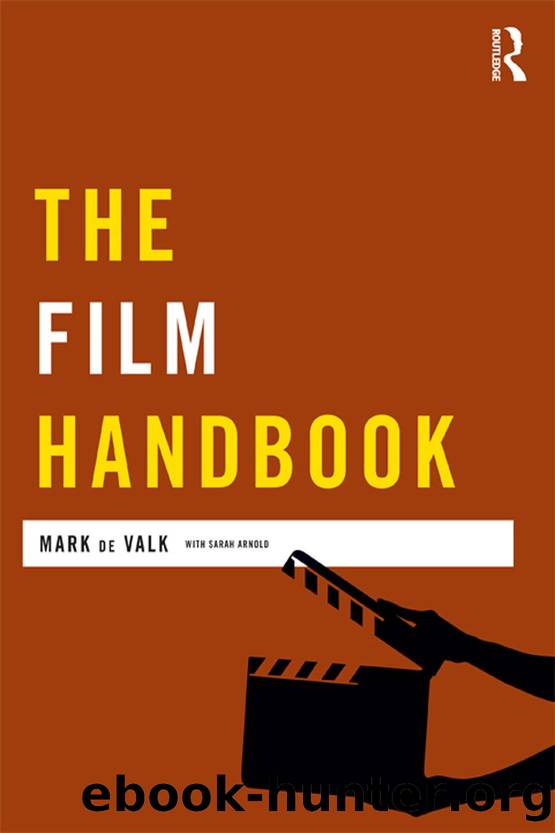The Film Handbook by de Valk Mark;Arnold Sarah;Arnold Sarah;

Author:de Valk, Mark;Arnold, Sarah;Arnold, Sarah;
Language: eng
Format: epub
Publisher: Taylor & Francis Group
Keep these questions in mind as you read through the material and take note of any ideas you have that arise from the reading that might infuse your own filmmaking practice. You will derive great benefit and use in applying these questions and thoughts to particular cultural theorisations as a means to draw thematic and image inspiration.
CULT FILM â THEORY UNDERPINNING PRACTICE
C@SE STUDY
Edited excerpts from Notes Toward a Masochizing of Cult Cinema: The Painful Pleasure of the Cult Film Fan, by David Church (used by permission of the author and Offscreen online journal).
The phenomenon of cult cinema is most often generated by the dual combination of a) textual peculiarities and b) specific audience reading/consumption strategies. Violence and sexuality of a deviant or perverse variety are generally the key motifs in most cult films, as are other forms of taboo breaking and transgression that somehow set these films apart as âless accessibleâ to all tastes (typically through opposition to bourgeois social norms). Often situated both within and against low/mainstream/mass and high/elite/art tastes, cult films are also marked by âformal bizarreness and stylistic eccentricityâ denoting a predilection for considerable excess (Sconce 1995, p. 386).1 Excessiveness and eccentricity are also traits commonly attributed to cult movie buffs, and it is the particular devotion of the cultist that will be my primary focus in this essay.
My starting point will be an understanding of all film spectatorship as masochistic, a theory most usefully advanced by Gaylyn Studlar and Steven Shaviro. Following Deleuzeâs early work, Studlar (1988) posits that the cinematic apparatus serves as a âdream screenâ that causes regressive spectatorial pleasures hearkening back to the infantâs experience of perceived union with the pre-oedipal (or oral) mother representing plenitude. As a form of (un)pleasure open to male and female spectators alike, cinema unleashes these repressed desires for symbiotic re-union with the motherâs body as the spectatorâs ego boundaries are temporarily dissolved and he/she is fixed in a submissive position of inability to control the dreamlike images being projected, while identification with on-screen characters remains bisexually fluid and constantly shifting.
Barry Keith Grant (2000) argues that cult films âshare an ability to be at once transgressive and recuperativeâ (p. 19) because the excessive and taboo-breaking qualities of the text are merely temporary, for social order is eventually restored at narrativeâs end. As an example, he notes that Rocky Horrorâs campy, bisexual excesses are finally ended once Dr. Frank-N-Furter is destroyed at the conclusion, leaving the heterosexual couple Brad and Janet reunited. Grant explains that cult films also encourage viewers to âlaugh at the normal, tame the Other, but nowhere see themselvesâ (p. 27), because typically caricatured representations of the Other serve to cast all characters along solid binary oppositions (e.g., normal/abnormal, establishment/anti-establishment, straight/gay, male/female, etc.), allowing viewers no solid points of identification in between.
Sconce (1995) describes how âparacinemaâ (exploitation film) cultists define their tastes as a sort of âcounter-cinemaâ (e.g., through violations of continuity editing, suturing, etc.) opposed to both mainstream Hollywood cinema and elite art cinemaâso perhaps
Download
This site does not store any files on its server. We only index and link to content provided by other sites. Please contact the content providers to delete copyright contents if any and email us, we'll remove relevant links or contents immediately.
Still Foolin’ ’Em by Billy Crystal(36037)
Spell It Out by David Crystal(35840)
The Great Music City by Andrea Baker(30779)
Professional Troublemaker by Luvvie Ajayi Jones(29417)
Trainspotting by Irvine Welsh(21012)
Call Me by Your Name by André Aciman(19895)
We're Going to Need More Wine by Gabrielle Union(18626)
The Secret History by Donna Tartt(18151)
Cat's cradle by Kurt Vonnegut(14757)
Ready Player One by Cline Ernest(13975)
Molly's Game by Molly Bloom(13885)
Bombshells: Glamour Girls of a Lifetime by Sullivan Steve(13680)
The Goal (Off-Campus #4) by Elle Kennedy(13192)
Leonardo da Vinci by Walter Isaacson(12788)
The Social Justice Warrior Handbook by Lisa De Pasquale(11950)
4 3 2 1: A Novel by Paul Auster(11786)
The Break by Marian Keyes(9075)
Crazy Rich Asians by Kevin Kwan(8883)
Adultolescence by Gabbie Hanna(8584)
